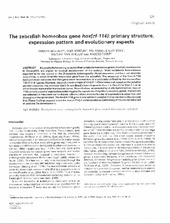The zebrafish homeobox gene Hox(zf-114): primary structure, expression pattern and evolutionary aspects
Peer reviewed, Journal article
Published version

Åpne
Permanent lenke
http://hdl.handle.net/1956/21610Utgivelsesdato
1992Metadata
Vis full innførselSamlinger
Sammendrag
It is gradually becoming accepted that vertebrate homeobox genes, like their counterparts in Drosophila, are crucial for normal development of the embryo. Most vertebrate homeoboxes reported so far are related to the Drosophila Antennapedia (Antp) sequence, and here we describe hox[zf-114], a novel Antp-like homeobox gene from the zebrafish. The sequence of the hox[zf-114] homeodomain indicates that this gene could be a member of a subfamily defined by the mouse Hox-1.5/-2.7/-4.1 genes. However, the evolutionary origin of hox[zf-114] is unclear and, based on the putative protein sequence, we conclude that it is not directly homologous to Hox-1.5, Hox-2.7 or Hox-4.1, or to other known mammalian homeobox genes. Nevertheless, as revealed by in situ hybridization, hox[zf-114] exhibits a spatial expression pattern typical for vertebrate Antp-like homeobox genes. Transcripts are detected in the posterior hindbrain, where a sharp anterior border of expression is observed, and throughout the spinal cord. The hox[zf-114] gene is also active in a region that gives rise to the pectoral fins. These findings suggest a role for hox[zf-114] in anteroposterior patterning of the neural tube and in pectoral fin development.